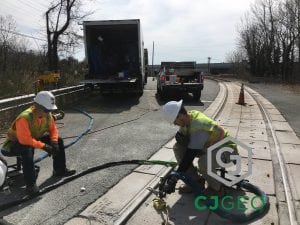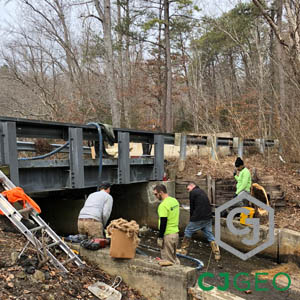Polyurethane Grouting Projects
-

9″ Floor Lift
THE JOB 9″ floor lift for 6,000 square feet of slab floor in a flex space building in Bosto...
-

Runway Slabjacking
THE JOB This runway slabjacking project is located in Norfolk, Virginia, at a military base. The ...
-

25VF stormwater manhole sealing
THE JOB Leaks throughout the joints on a 25VF, 48″ precast stormwater manhole were leaking....
-

15 inch RCP point repair
The Job This 15 inch RCP point repair project is located near Richmond, Virginia. A 6′ deep sinkh...
-

RCP Pipe Sealing
THE JOB This RCP pipe sealing project is located in Wake Forest, North Carolina. The asphalt park...
-

Chemical Underpinning
The Job This chemical underpinning project is located outside of Pittsburgh, Pennsylvania at a ma...
-

Bridge Approach Polymer Grouting
The Job This bridge approach polymer grouting project is located just outside of Washington, DC. ...
-

Commercial Floor Void Fill
THE JOB This commercial floor void fill project is located in Manhattan. During a Local Law 11 in...
-

Port Shed Floor Stabilization
THE JOB This port shed floor stabilization project is located in Baltimore, Maryland. The 11″ thi...
-

Office Floor Settlement Repair
The Job This office floor settlement repair project is located near Norfolk, Virginia. The slab f...
-

Mine Shaft Abandonment
The Job This mine shaft abandonment project is located in an area with a significant number of ab...
-

Tunnel Abandonment – Boston
THE JOB A plumbing contractor hand tunneled 140LF of 4’x5′ tunnel under two apartment buildings n...
-

Railroad Sinkhole Stabilization
The Job This railroad sinkhole stabilization project is located in Martinsburg, West Virginia. Du...
-

School Floor Leveling
The Job This school floor leveling project is located in Princeton, West Virginia. The Princeton ...
-

Light Rail Tub Crossing Repair
This light rail tub crossing repair project is located in Charlotte, North Carolina. It is part o...
-

Industrial Driveway Crossing Repair
The Job This industrial driveway crossing repair project is located in Frederick, Maryland. MARC&...
-

NC Tub Crossing Repair
THE JOB This NC tub crossing repair project is located in Charlotte, North Carolina. The 8′ long ...
-

Industrial Short Line Tub Crossing Repair
The Job This short line tub crossing repair project is located in Baltimore, Maryland. Sparrows P...
-

Tub Crossing Repair
The Job This tub crossing repair was done for a short line railroad in New Jersey. The sandy soil...
-

PA Turnpike Undersealing
The Job This PA Turnpike undersealing project is located on the Northeast Extension of the Pennsy...
-

Coal Pier Sinkhole Grouting
The Job This pier sinkhole grouting project by CJGeo is located at the mouth of the Elizabeth Riv...
-

Sewer Collapse Sinkhole Repair
The Job This sewer collapse sinkhole repair project is located in central Virginia. When the oper...
-

Corporate HQ Stabilization
The Job Starting immediately after construction was completed, the slab on the grade floor within...
-

Multiplate Tunnel Grouting
The Job This multiplate tunnel grouting project is located in Asheville, North Carolina. During a...
-

Fire Station Floor Lifting
The Job This fire station floor lifting project is located about an hour east of Richmond, Virgin...
-

25MGD Sinkhole Leak Grouting
The Job An underground minerals mine started to lose up to 8VF per day of mine due to water infil...
-

Dollar Store Floor Void Filling
The Job This floor void filling project is located about three hours west of Richmond, Virginia. ...
-

Hotel Basement Water Intrusion Grouting
The Job This basement water intrusion grouting project was at a hotel in Baltimore, Maryland. It ...
-

Bridge Approach Ground Improvement
The Job This bridge approach ground improvement project by CJGeo is located in Richmond, Virginia...
-

Spillway Bridge Grouting
The Job This spillway bridge grouting project is located in Toano, Virginia. Toano is between Wil...
-

North Carolina Tub Crossing Repairs
The Job This tub crossing repairs project is located in Charlotte, North Carolina. Fifty two OldC...
-

CBBT Sheet Pile Pregrouting
The Job This sheet pile pregrouting project is located in the Chesapeake Bay. The Chesapeake Bay ...
-

Warehouse Floor Joint Stabilization
The Job This floor joint stabilization project is located in Ashland, Virginia. About two months ...
-

New Jersey Grade Crossing Stabilization
The Job This grade crossing stabilization project is located in Edison, New Jersey. A precast mod...
-

Norfolk polyurethane grouting
The Job This Norfolk polyurethane grouting project is located on a military base. The medical cli...
-

8′ CMP Joint Grouting
The Job A spec warehouse was planned for a vacant piece of land which had 1700LF of 8′ CMP ...
-

Chicago polyurethane grouting
The Job This Chicago polyurethane grouting project is located at BNSF’s Willow Springs Inte...
-

Illinois Spillway Grouting
The Job A spillway serving as a dam for a lake owned & maintained by a property owner associa...
-

Valve Vault Infiltration Grouting
The Job This valve vault infiltration grouting project is part of the Purple Line project in Mary...
-

New York Tub Crossing Lifting
The Job Eight panels of StarTrack modular grade crossing tubs settled. As a result of the settlem...
-

NY Grade Crossing Repair
The Job 10 panels of StarTrack modular grade crossing tubs settled in an urban street crossing ow...
-

Sheet Pile Joint Sealing
The Job This sheet pile joint sealing work is part of the Thimble Shoals parallel tunnel project....
-

Coke Gas Pipe Fill
The Job This coke gas pipe fill project is located in Middletown, Ohio, at Cleveland Cliff’...
-

North Carolina Compaction Grouting
The Job This North Carolina compaction grouting project is located at a military facility in east...
-

New Jersey polyurethane grouting
The Job This New Jersey polyurethane grouting project is located in Creskill, New Jersey. As part...
-

Massachusetts Lightweight Fill
The Job This Massachusetts lightweight fill project is located at Boston’s Logan Internatio...
-

Maryland compaction grouting
The Job This Maryland compaction grouting project is located on East West Highway, in Chevy Chase...
-

Stormwater Sinkhole Repair
The Job This stormwater sinkhole repair project is located at a data center near Dulles, Virginia...
-

Box Culvert Void Filling
The Job This box culvert void filling project is located near Fredericksburg, Virginia. The Virgi...
-

Maryland Concrete Lifting
The Job This Maryland concrete lifting project is located in Frederick, Maryland. The project is ...
-

48 Inch RCP Joint Repair
The Job This 48 inch RCP joint repair project is located in Raleigh, North Carolina. The pipe is ...
-

Apartment Floor Lifting
The Job This apartment floor lifting project is on a military facility in Washington, DC. During ...
-

SOE Leak Grouting
The Job This SOE leak grouting project is located in Alexandria, Virginia. It is part of the Rive...
-

Outfall Leak Grouting
The Job This outfall leak grouting project is located near Emporia, Virginia. The work is located...
-

Virginia Polyurethane Grouting
The Job This Virginia polyurethane grouting project is located in Blacksburg, Virginia, at Virgin...
-

Bridge Approach Grouting
The Job This bridge approach grouting project is located near Lexington, Virginia. It is on Inter...
-

Michigan Polyurethane Grouting
The Job This Michigan polyurethane grouting project is located near Saginaw, Michigan. The work w...
-

RCP Joint Sealing
The Job This RCP joint sealing project is located near Charlottesville, Virginia. The polyurethan...
-

Flooded Shaft Grouting
The Job This flooded shaft grouting project by CJGeo is located outside of Washington, DC at a da...
-

Ohio Polyurethane Grouting
The Job This Ohio polyurethane grouting project by CJGeo was for a short line railroad near Scio,...
-

Penstock Void Grouting
The Job This penstock void grouting project is located near Hopkinton, New Hampshire. It is locat...
-

Tunnel Shaft Sinkhole Grouting
The Job This tunnel shaft sinkhole grouting project is located in Newport News, Virginia. It is l...
-

Yonkers Polyurethane Grouting
The Job This Yonkers polyurethane grouting project is located in Yonkers, New York. The project i...
-

Collapsed CMP Abandonment
The Job This collapsed CMP abandonment project is located at a paper mill near Richmond, Virginia...
-

Spillway Undersealing
The Job This spillway undersealing project is located at a dam in Tuckahoe, Virginia. The dam is ...
-

North Carolina Polyurethane Grouting
The Job This North Carolina polyurethane grouting project is located at Elon University. It is pa...
-

Jersey Turnpike Polyurethane Grouting
The Job This Jersey Turnpike polyurethane grouting project is located next to Secaucus Junction i...
-

Paved Slope Void Filling
The Job This paved slope void filling project is located in Interstate 95, near Rocky Mount, Nort...
-

Seawall curtain grouting
The Job This seawall curtain grouting project is located at a secure facility in North Carolina. ...
-

Fairfax Polyurethane Grouting
The Job This Fairfax polyurethane grouting project is located at a commercial building used for m...